Coarse Grind Vs Fine Grind Coffee – Espresso Gal’s How To Guide To Grinding For Black Gold
by Selmir Omic
The purpose of this article is to teach people who have no previous experience how to grind coffee beans using their coffee grinder at home.
As you might guess, there's a few simple guidelines you should follow in order to do this correctly - and you will thank yourself later as your coffee or espresso will be delicious!
Contents
- Coffee Grind Size Matters
- Grind Size & Brewing Method
- Coarse vs Fine Coffee Beans
- Difference Between Roasting Coarse and Roasting Fine Coffee Beans
- Grinding for Drip Coffee
- Pour Over
- The Importance Of Trial & Error at Coffee Grinding
- Grind Size Comparison Chart w/ Images
- How To Grind Coffee Beans: Basic Rules
- Flavor Extraction: How It Works
- Grind Size For French Press
- Flavor Extraction: Getting Picky
- Conclusion for Coarse Grind Vs Fine Grind Coffee
Coffee Grind Size Matters

Of course, learning how to grind coffee beans yourself, whether you're looking for a coarse French Press grind, or a finer espresso grind, can be a rewarding experience in more ways than one.
Really, there are two main rewards; one being learning a new skill, and the other benefit being fresh, delicious coffee you've made yourself! Plus, you save money by making coffee at home. 😀
Eventually, with practice, we know you'll be preparing cups of black gold that can make the best bartista in town's coffee taste like dishwater.
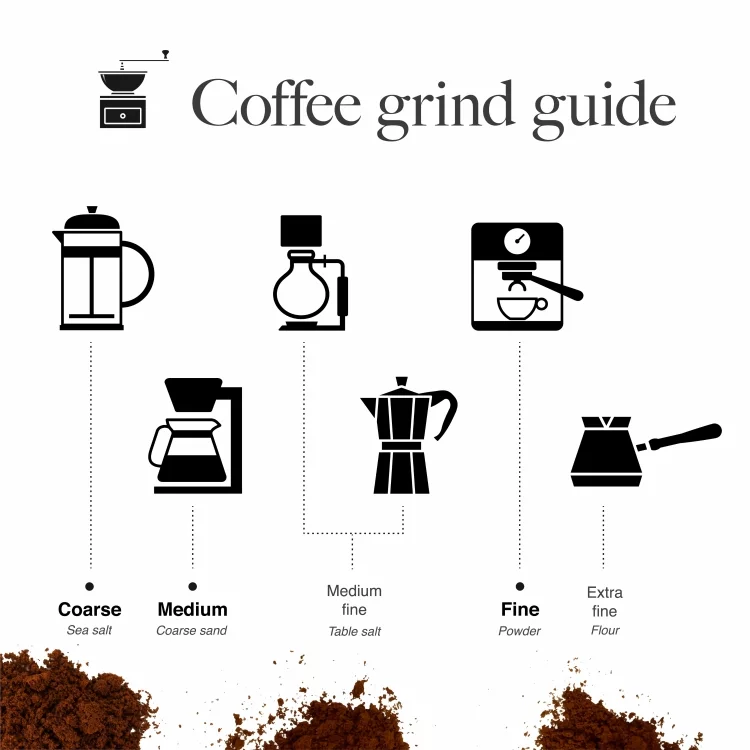
Well, maybe not, but at least it will put a few things into perspective where suddenly you will know if your local barista has been trained or not.
But lets not get ahead of ourselves, we still need to learn how to grind those beans.
Grind Size & Brewing Method
The main thing to know when you are about to grind coffee beans is being aware of the brewing method you will be using after the beans are ground up, because this will determine the grind size you want.
Here's a quick video from the folks at Whole Latte Love which illustrates this point perfectly.
As you can see, there's no one answer for how to grind. It will always depend on your brewing method.
So, depending on which of the type of brewing method you'll be using (and there are many ways to brew), you will need to adjust grind sizes to get the results you want.
By grind size, we mean the coarseness or fineness of the grind as this picture shows us.
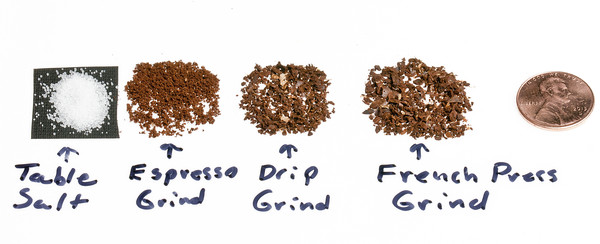
Coarse vs Fine Coffee Beans
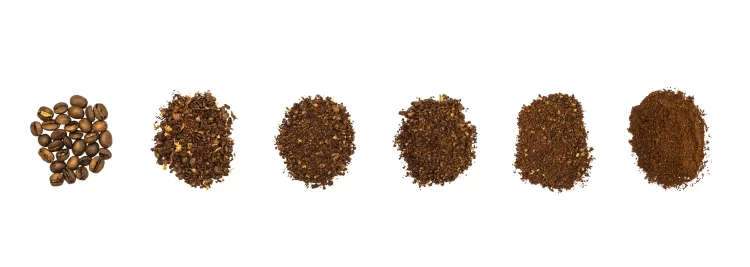
The degree in which your coffee is ground has a huge impact on how many flavor compounds are released into your brew, giving you an entirely different tasting cup of coffee. If the beans are too finely ground, they will be under-extracted resulting in a weaker cup of coffee (and vice versa).
The reason why the grind is so important to the taste of your final cup is because you are usually brewing with water that is between 195 - 205 degrees Fahrenheit (90-96 degrees Celsius), which causes the coffee beans to release their flavor. If your grind is too fine, you are losing some of those flavors because they are being cut up by your grinder.
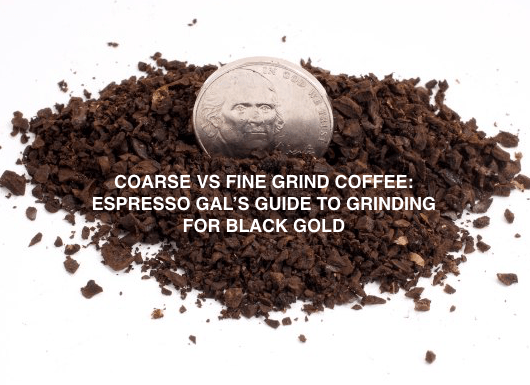
Additionally, if your ground is too coarse it will be under-extracted, resulting in a weaker tasting cup of coffee. This happens because of an issue with water flow; the water will have trouble flowing through the coffee particles, taking longer to extract flavor.
The best grind for your brew is medium-fine, which provides even extraction along with great tasting flavors. If you are stuck between choosing coarse or fine though, it all depends on the type of machine you are using. With drip brewers, choose a more coarse grind, but with espresso machines, aim for a finer grind.
The best way to get an idea of how coarse or fine you need your coffee ground is by playing around with it. I recommend buying several different types of coffee beans and testing out the various grinds to see what tastes best for you - because at the end of the day, it all depends on personal taste.
Difference Between Roasting Coarse and Roasting Fine Coffee Beans

While it may seem like a matter of course, there are some key differences. Let's get an insight on them one-by-one:
Linger Time
Though both need to be roasted long enough so that the flavor oils come to the surface, the time required also depends on how coarse or finely are they ground.
How do you roast coffee beans? A finer grind needs a shorter time of about 7 minutes, while coarser grinds need 10-12 minutes.
Roasting Temperature & Roast Time
While fine coffee beans need to be roasted at a lower temperature so as not to burn the beans and ruin the taste, coarsely ground beans don't need such care.
The roasting temperature for fine coffee beans is set at 200-220 degrees Celsius ( 392 - 428 Fahrenheit), while that of coarsely ground ones is 230-240 degrees Celsius ( 446 - 464 Fahrenheit).
Both of them, however, need to be roasted for about 12 minutes.
Color of the Roasted Beans
Fine coffee beans tend to roast darker than coarsely ground ones. But it is important to follow recommended roasting times because if the roast time is too long; certain beans might even get burnt.
Roasting Procedure
How you roast your coffee beans depends a great deal on the type of roaster or machine that's being used for this purpose. For example, while some machines have a rotating basket where the beans are placed and roasted, there are others which use heated plates with grooves to roast the beans for evenly cooked coffee.
No matter what kind of roaster you use, there is a recommended time and temperature to be followed for roasting both kinds of coffee beans: Coarse-grade coffee beans: 7 minutes at 200 degrees Celsius (392 Fahrenheit) Fine-grade coffee beans: 12 minutes at 180 degrees Celsius (356 Fahrenheit)
Grinding for Drip Coffee
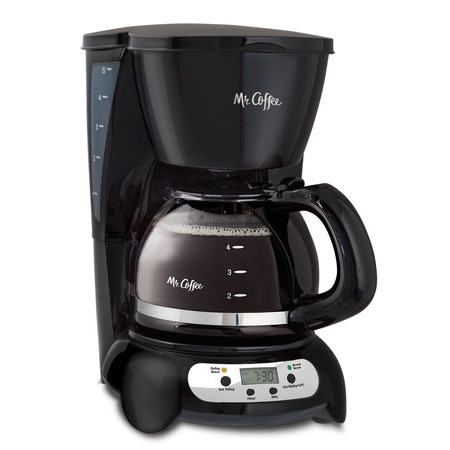
Drip coffee is made through the standard coffee maker, where ground beans are scooped into a filter, the water heats up and drips down into the carafe on the burner below.
This is ideal for higher volume of coffee. It's your standard home brew coffee situation, but it can turn out rather well if the person making it is in the know.
We asked our friend Liam, AKA The Autistic Barista, what he thinks about grinding for drip coffee at home.

"Get a burr grinder - blade grinders wont work as well. Try to find a good midway point in grind size and work form there. You don't want too fine or too coarse.
If you are stuck with a blade grinder, I recommend you check out James Hoffman's tutorial, where gives techniques and "hacks" to make a consistent grind with a blade grinder.
Since Liam is a barista, we asked him about grinding for drip coffee in a café environment. "What is required for the best results?", we asked him, triggering some strong opinions.
"CARE. A lot of rosters who are too pretentious about coffee will write off their drip coffee as a nothing special and have that option available for the average consumer who is used to Starbucks and McDonalds.
In doing this, they often lie and put the least amount of work into that roast. This is a terrible idea.
If you put time and care into your automatic drip brewers grind to water ratio as well as brew time, you will make an amazing product that will wow your customers!
In fact, there are helpful ratios and graphs on the web that can help you work out your own recipe. I advise having two options on batch brew that will wow your clientele.
Tip #1: An Option That Will Work Well With Milk and Cream
Its always wise to have an option that will work well with milk and cream as some people will make those additions, regardless the care you put into the roast.
So keep that in mind when doing your cupping sessions and R&D. If you nail that, you will nail your product and create a great word of mouth.
Tip #2: A Single Origin on the Opposite End of the Flavor Spectrum
Have a single origin on the opposite end of the flavour spectrum to your first roast. This will be different enough that your customer will be presented with an easy and simple choice for their preference.
Tip #3: Make One a Medium Light and One a Medium
This is more of a hack, but make one a medium light and one a medium (medium dark) and just say that second medium is a dark. People think these terms, but will be wowed by the quality."
If all of that seemed a bit technical, read on, because we break all of the grinding tips down later in the article.
Pour Over
Looking for something a little coarser so you can make a great French press or pour over style cup of coffee?
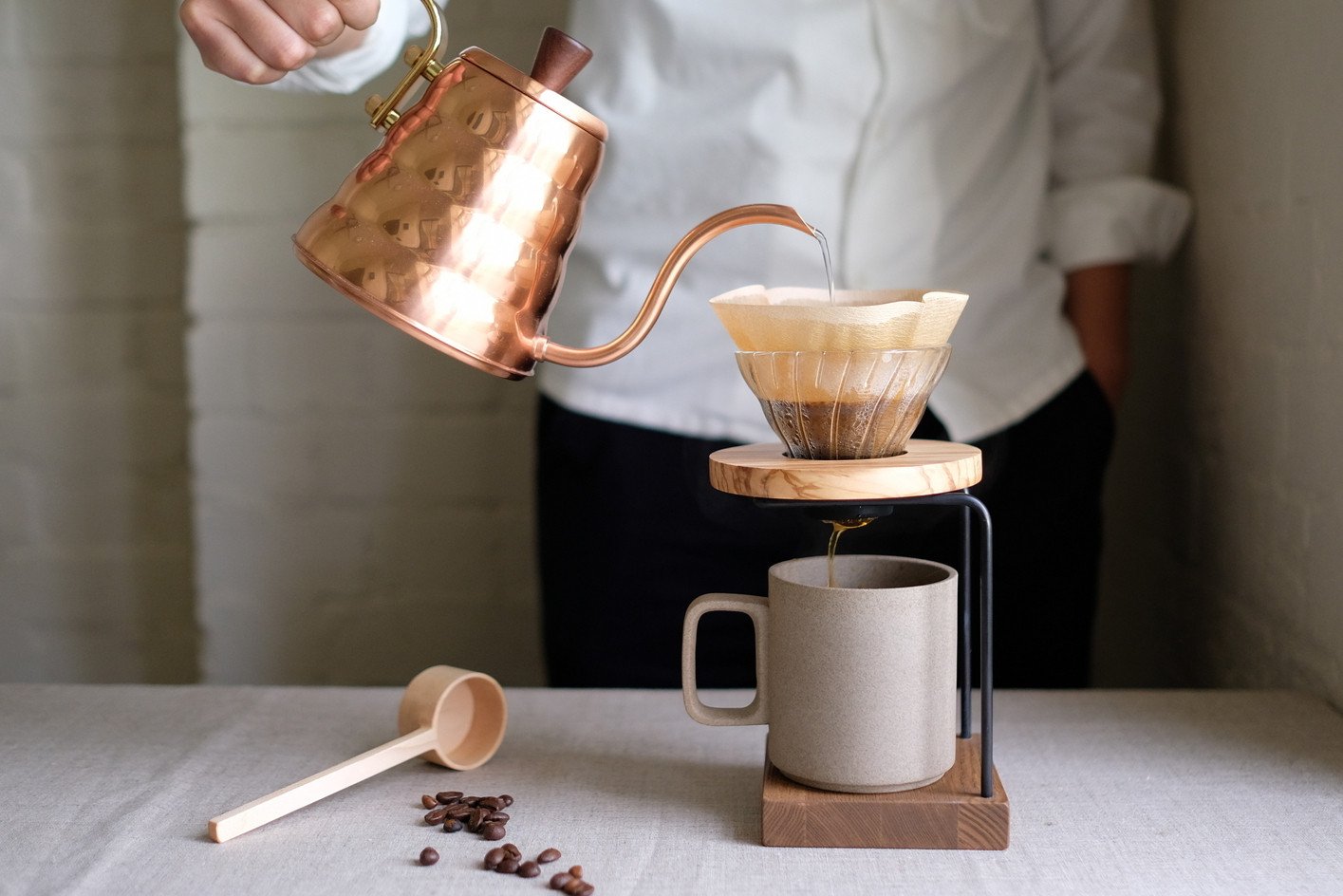
French press is a very convenient way to make coffee: boiled water is added to a beaker-shaped vessel, left to steep with the ground coffee.
Then the top is pressed down to the bottom to hold the grinds in place while you pour your coffee.
Pourover involves pouring hot water over the grinds and letting it steep slowly in a one-serving kind of way.
The Baratza Encore is a solid choice, as we said before.
Or perhaps espresso is what you're after?
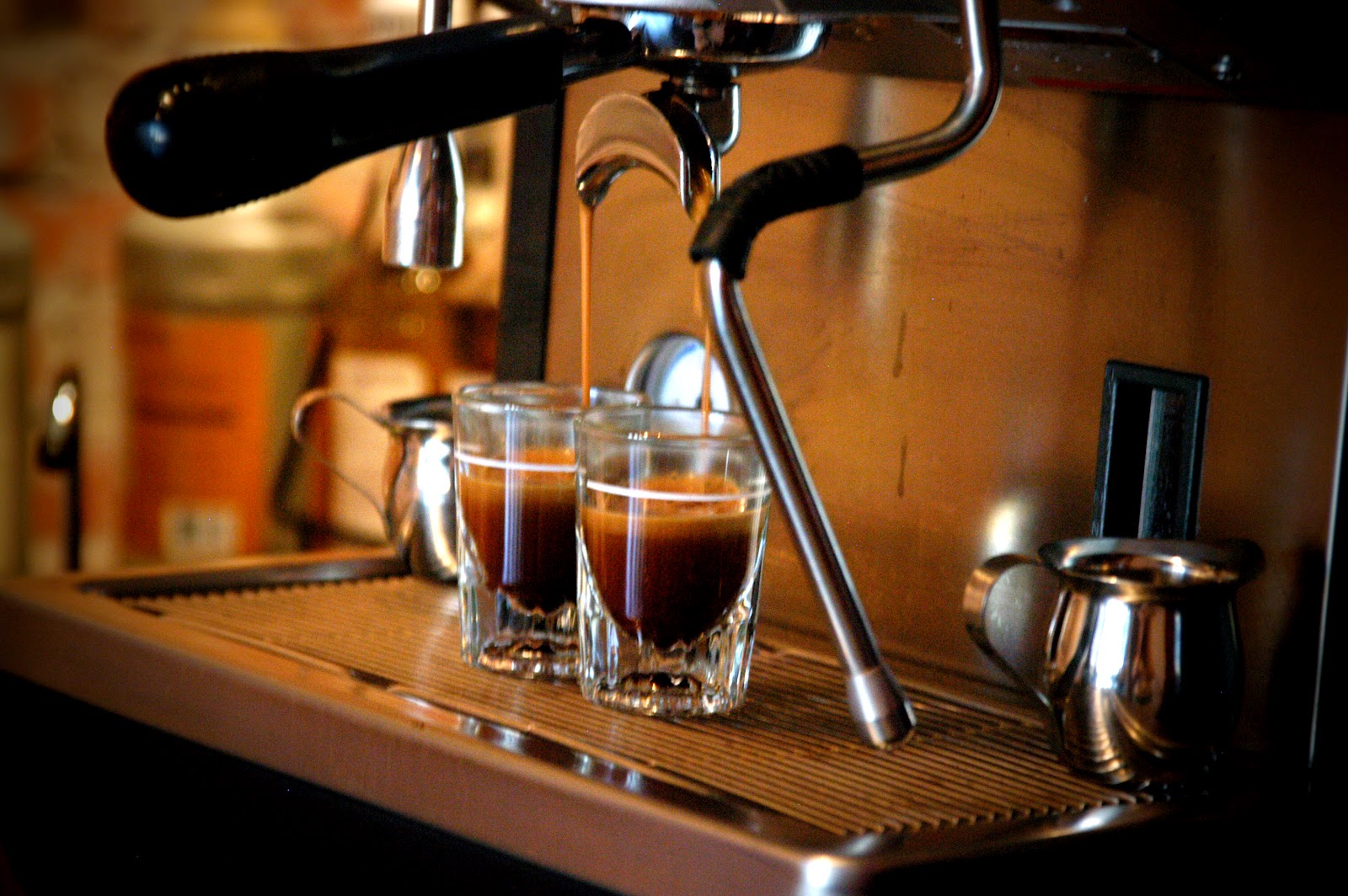
You'll need a coffee grinder that is superb when it comes to find grinding, like the Rancilio Rocky.
The Importance Of Trial & Error at Coffee Grinding
If you're making coffee at home, and that's the way you want to go, you need to consider something.
That is, even if you have a great coffee maker, and premium coffee beans, and delicious filtered water - you can still ruin your cup of coffee if the beans aren't ground correctly.
That's why I'm here - to prevent that from happening with a bit of education.
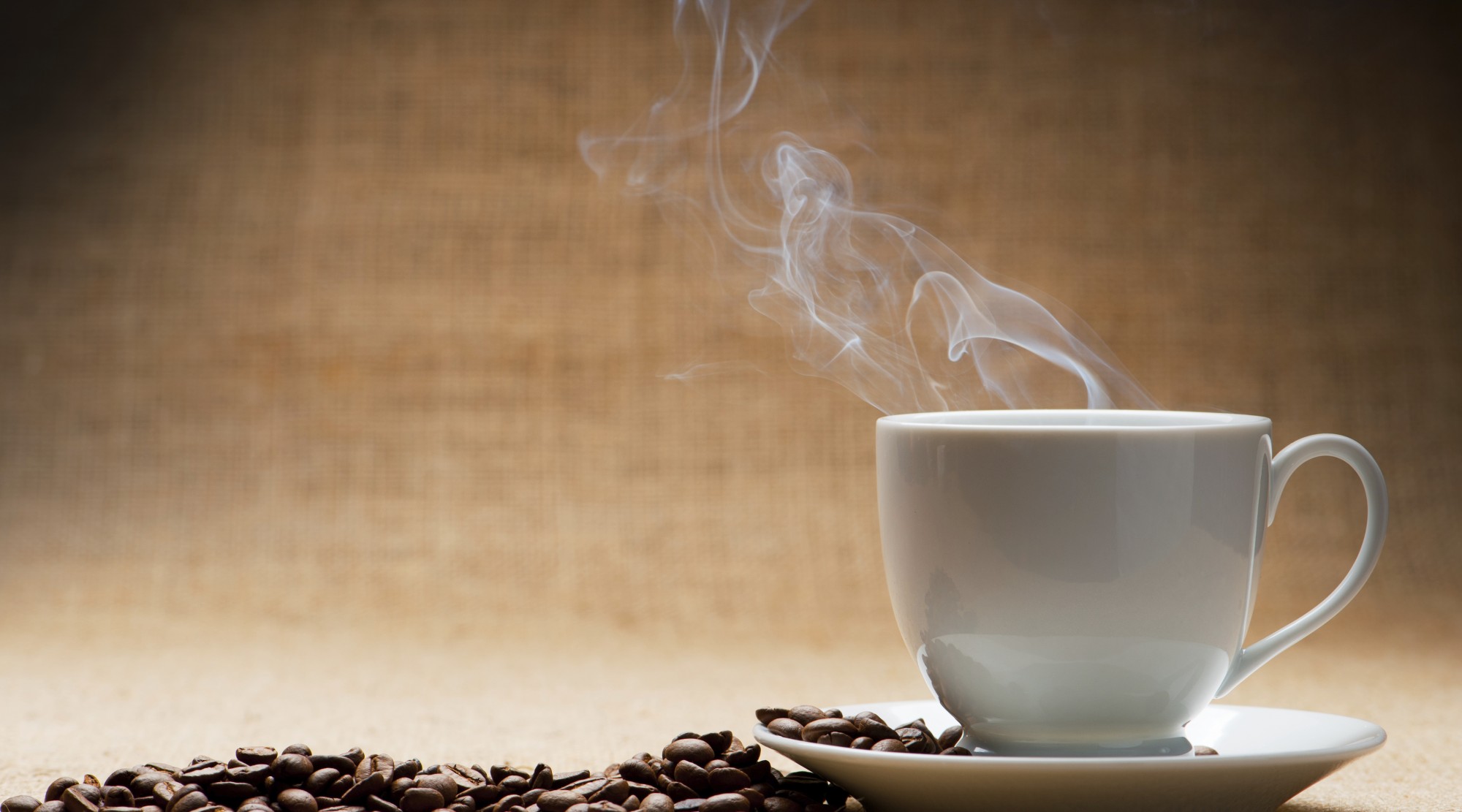
That said, if you're new at coffee grinding you should expect to make a few less-than-perfect cups of coffee before getting the hang of it.
Once you've been through the process of how to grind coffee beans yourself a few times, you will no doubt start producing better and better results in the form of delicious cups of coffee and/or espresso!
With grinding, the goal is to expose the unique characteristics of your chosen coffee bean by preserving its essential oil and extracting its natural flavor.
It's going to take some time to get the perfect coarseness and flavor.
You should also experiment with your preferred method of preparing coffee.
Do you enjoy the whole process?
Do you want to enact a barista's role at home, and do the whole thing from start to finish: grinding the beans before each cup?
Do you want a whole pot of coffee to guzzle down, or would you prefer to savour one or two mugfuls?
Some people even prefer different coarseness because of the sound produced when handling the grinds.
Now, on to looking at the grind size specifications a little bit closer.
Grind Size Comparison Chart w/ Images
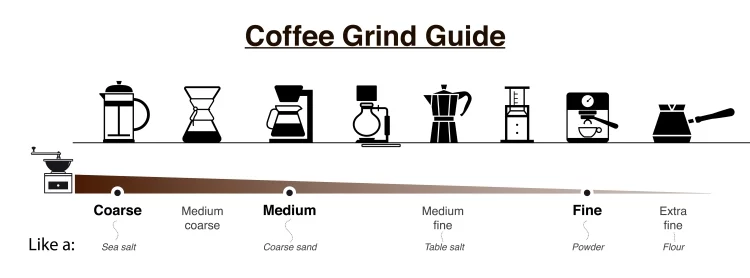
Coarse Grind

- Distinct, chunky, pieces of coffee beans
- Similar to heavy kosher salt
- Preferred brewing method: French Press
Medium Grind

- Gritty texture with visible flakes
- Similar to coarse sand
- Preferred brewing method: Drip coffee
Fine Grind
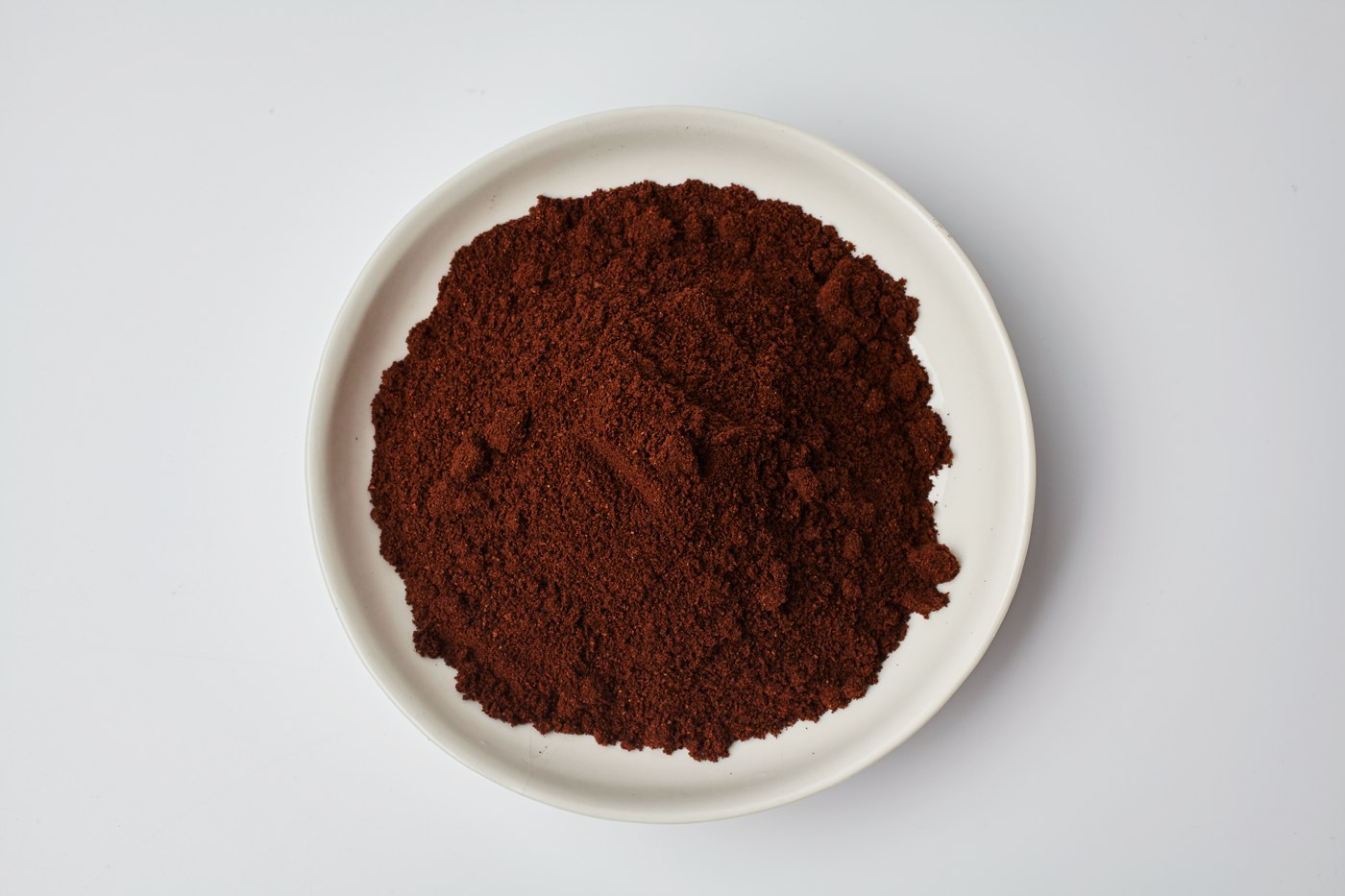
- Much smoother texture
- Similar to table salt
- Preferred brewing method: Espresso
Extra Fine Grind
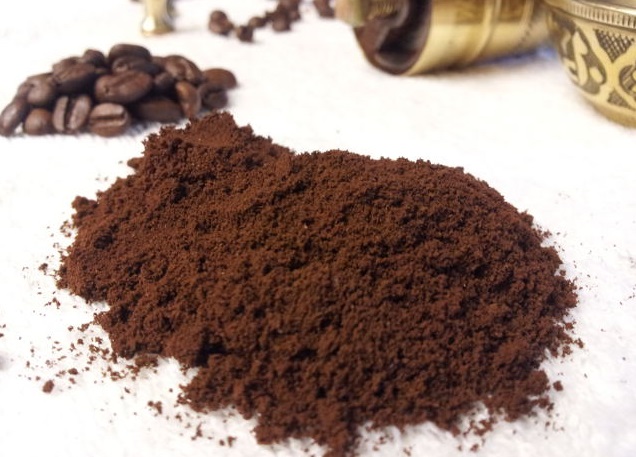
- Powdery, similar to flour
- Blade grinders cannot grind this fine even on a good day
- Preferred brewing method: Turkish
How To Grind Coffee Beans: Basic Rules
Ok, now that you've seen how the grinds should look, these are the some basic, yet important, rules to grinding coffee you should think about.
To start you need the best coffee grinder you can afford to get, so make sure you have that sitting on your counter before we begin.
Also, grab a bag of the freshest and best coffee beans you can get your hands on.
Besides the grinder and the beans, you're also going to have to know how you're going to brew your ground coffee. As we said before, different brewing methods call for different grinds, so it all depends.
Three Basic Rules For Good Grinding
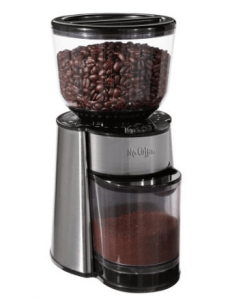
However, since we can't predict what brewing method you'll be using, let's just take a look at a few general rules for good grinding when it comes to coffee to start with.
- For freshness, always grind your coffee right before you brew
- Decide on your grind size and adjust your machine accordingly
- Keep your grinder clean before and after uses
Theoretically, if you can remember these three simple rules, you should be in good shape starting out. But in practice, are these rules easier said than done?
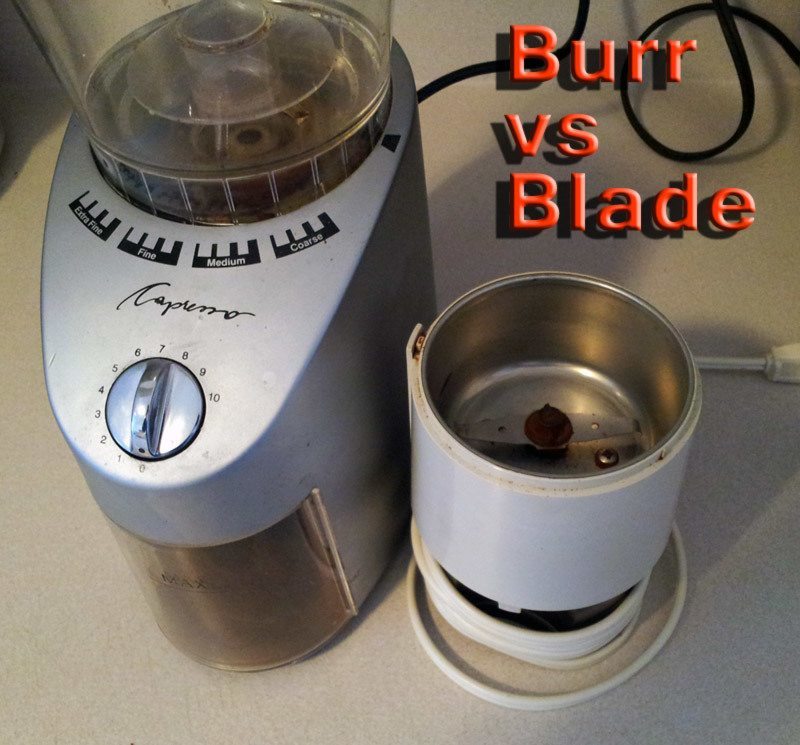
Since this is your basic beginner course on grinding coffee beans, we should now explain something we talk about at length on this site, in many of our articles.
That is, there are two types of coffee grinder: burr grinders and blade grinders.
If you've never ground up a bean in your life, this is pretty significant information in your coffee journey.
Before we get into the specifics of grinding the beans, we want to talk about each of these types of grinders for a minute.
If you already have your grinder plugged in and ready to go, that means you've already made this choice, because you will either have one type of grinder or the other sitting before you.
If you feel like skipping this next section and going straight to the section below on grind size, you're more than welcome to do so.
Just keep in mind, that each type of grinder grinds differently, so the more you know about each kind of grinder, the better off your coffee will be. Knowledge is power!
Blade Grinder Basics
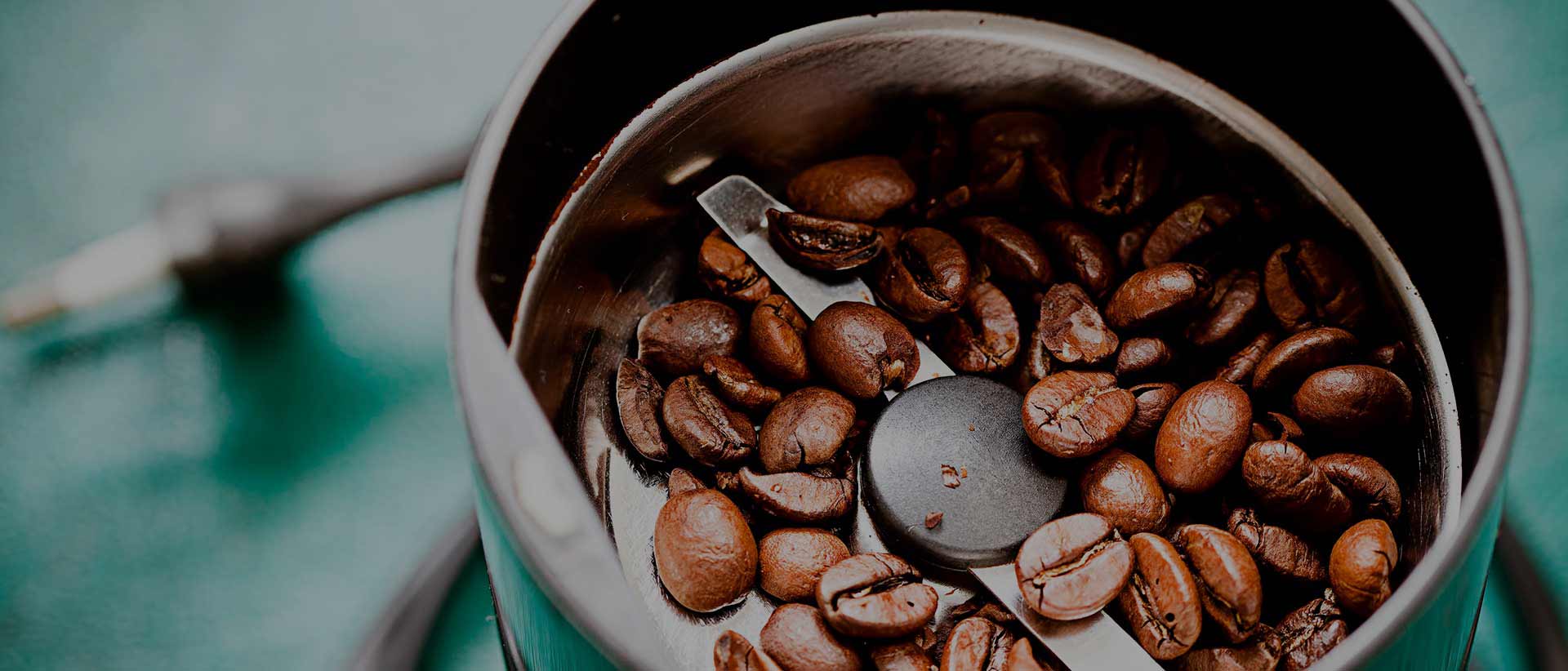
Blade grinders are usually the more inexpensive of the two types of grind, often running you $30 or less.
These grinders use blades that resemble helicopter blades and literally chop at the coffee beans until they're ground up.
Generally speaking, you control the resultant grind size as the blade spins, and you control its speed manually.
Blade grinders are good for basic use.
In our article, Best Coffee Grinder Under $50, it so happens that the Krups F203 wins out as "best grinder" for its price point, because its really quite economical and handy, beating out even some popular burr grinders.
Here now are some advantages and disadvantages of blade coffee grinders.
BLADE GRINDER ADVANTAGES:
- Inexpensive - Most models are under $30
- Easy to operate - Simply push the button to pulse the blades
- Easy to clean - Simple design with one removable part
- Easy to store - Smaller size takes up less room
- Faster grind - Toss in your beans and push the button, works fast
BLADE GRINDER DISADVANTAGES:
- Inconsistent grind at times - Some beans are turned to powder and others are in chunks
- No Portion Control - You have to measure your beans for each use
- Overheats the beans - Resulting in adversely affected flavor
- Less Capable - Can't do a fine grind as well, generally
Burr Grinder Basics
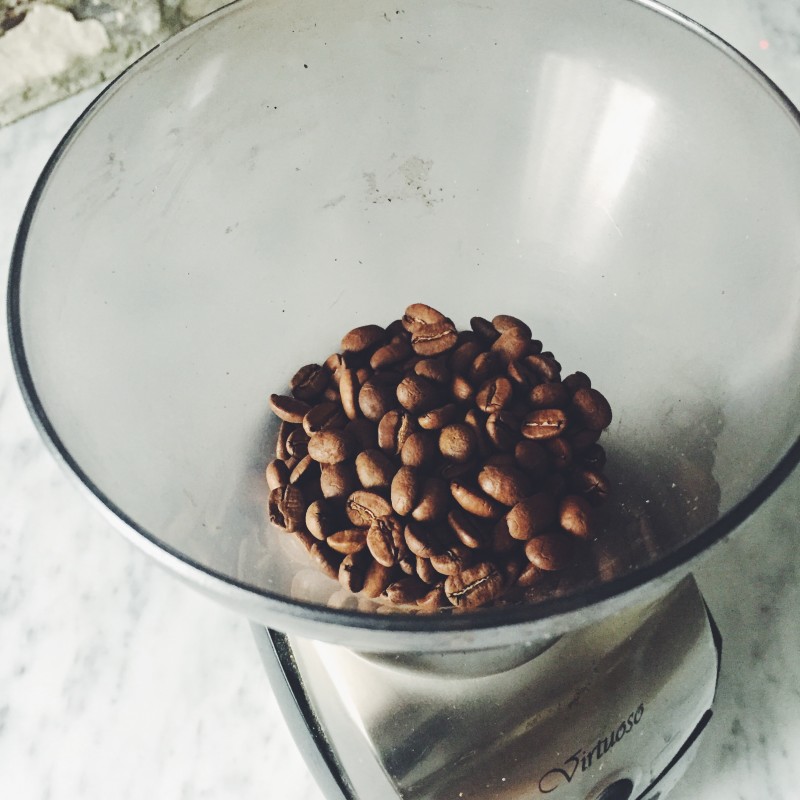
Burr grinders effectively crush or mash your fresh whole coffee beans between two pieces of metal or ceramic surfaces called burrs, rather than the old hack and slice method of blade grinders.
Burr grinders are, in most cases, far more effective than blade grinders, which is why we try to recommend burr grinders if at all possible, although this can be a bit of budgetary concern as the difference in price between a burr grinder and a blade grinder can be quite stark.
A Note About Manual Coffee Mills
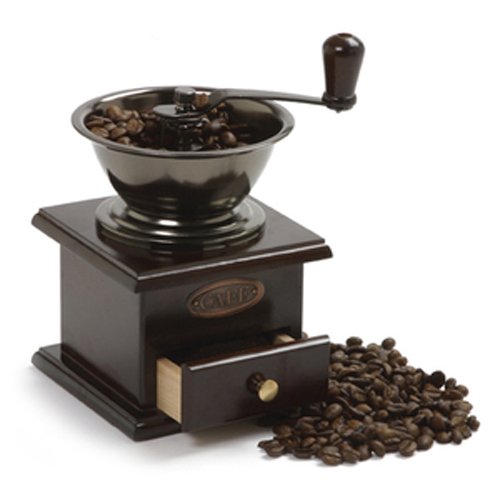
Keep in mind that manual coffee mills are also considered to be burr grinders because…well, they use burrs.
They are also relatively cost effective, in the same way that blade grinders are.
The "downside", according to some coffee fans, is that manual coffee mills (think pepper mill) are slow. We can't argue this.
They are a lot slower compared to electric grinders, whether we're talking about electric burr or blade grinders.
When you talk to any coffee buff or barista about coffee grinders, they will tell you that burr grinders are better than blade models, hands down.
There are two different types of burr you find in burr grinders that make a difference.
Flat Burr Grinder
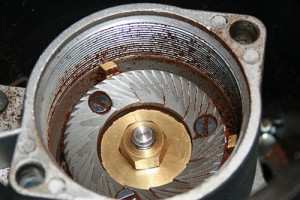
Flat burr grinders are generally the less expensive of the two types of burr grinders.
These tend to be a little messier and noisier due to the speed of the motor and the heat it produces.
Flat burr grinders like the Baratza Vario are still great and loved by fans and it produces flavorful results, but, by and large, flat burr grinders are not quite as respected in the coffee business as conical burr grinders, though, in specific terms, it will always depend on the model.
One reason the pros go for conical burr grinders is because of the fact that conical burr grinders use gravity vs. centrifugal force. More on that momentarily.
Conical Burr Grinders
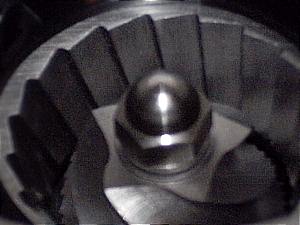
The top cone-shaped burr spins slowly in this model, which makes for a far less messy and quieter grind.
Conical grinders are great for oily (dark roasted) or flavored beans, as they are less likely to clog than flat burr grinders.
While they tend to be more expensive, the conical burr grinder is definitely worth the extra money, especially if you plan on grinding on a daily basis.
The burr on the above left is from the Breville Smart Grinder one of our favorites.
Here is a point form list of the advantages and disadvantages of your average burr grinder, which might have either a flat or conical burr set.
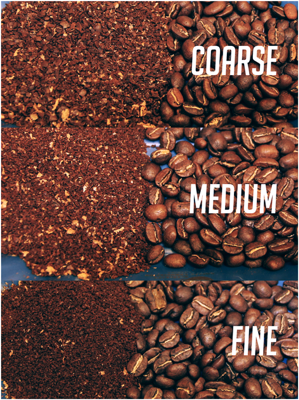
BURR GRINDER ADVANTAGES:
- Grinds Evenly - Even, consistent grind
- Variety of Grind Adjustments - From fine to coarse, some even do Turkish.
- Preserves Flavor- Doesn't overheat like a blade grinder
- Slower - A methodical and slow grind for more consistency
- Quieter - Burr grinders tend to be less noisy
BURR GRINDER DISADVANTAGES:
- More Expensive - But you get what you pay for
Flavor Extraction: How It Works
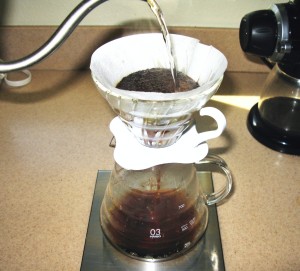
This will depend greatly on your brewing method, but we do still want to discuss extraction briefly in general.
When water (the extraction agent) makes contact with the coffee grounds it determines how much flavor the resulting brew will yield.
More contact means more flavor. The finer your coffee grounds are, the more surface there is for the water to extract the flavor.
In espresso parlance, it's called "pulling a shot".
Essentially, the purpose of roasting the coffee bean is to evaporate the moisture out.
The intense heat forces or squeezes water out of the bean, but also draws out its natural oils.
Coffee is actually 71% fatty acids.
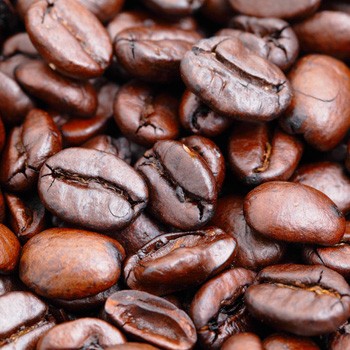
We want these oils! These oils, once extracted, render the bean in an oily coating. This is what gives the bean its particular flavour in addition to its colour.
Lighter roasts will, while providing more caffeine, be less oily and lighter in flavour, while darker coffees are more oily. You can tell if beans have gone stale by a dryness.
The minute you grind the beans, you are breaking down the pieces and this means the oil seeps out more (like we described water extracting the flavour from more surface).
The best way to ensure the tastiest, most refreshing cup is to grind your beans immediately before brewing. You will notice the best quality cafes always grind your beans right before they make your drink.
That's why the fancy cafes are addictive and that's why we're here to help you save some money: by doing the same tricks.
Otherwise, ground coffee may only have a real shelf life of two weeks - and that's in a dark container away from light.
Grind Size For French Press
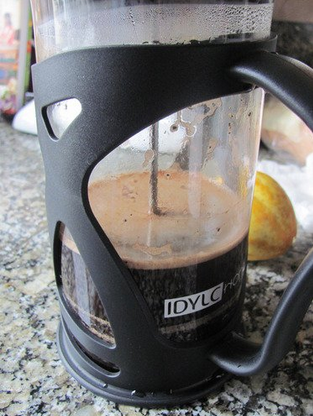
For other brewing methods like the famous French Press, its when the water and coffee grinds mingle together that the magic happens - and grind size matters for this!
If you are plan on doing any French Press grinding, here is an article which specifically talks about how to achieve the right grind size for the French Press and the right grinder for the job.
The coffee lover in the following video, for instance, uses the KRUPS F203 blade grinder for French Press and gets exactly what he wants out of it.
Flavor Extraction: Getting Picky
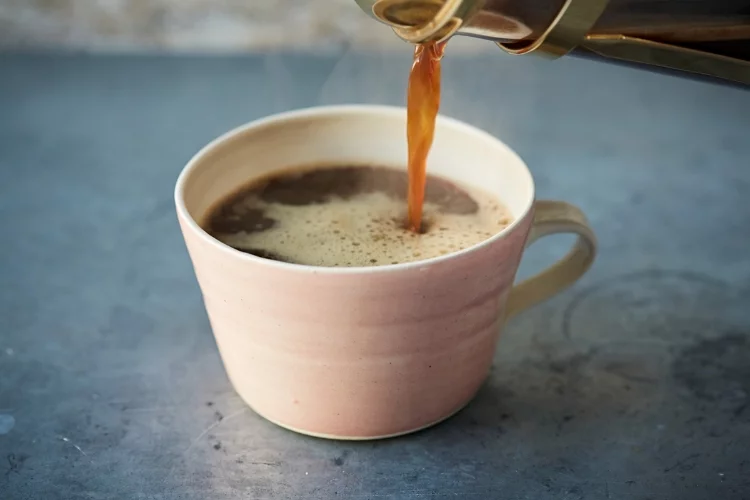
A quick note about beans: the amount of oil content in a particular bean will determine its colour. For example, more oil gives a darker colour. This affects the taste of the coffee.
Generally speaking, coffee brewed with grounds that are too coarse are going to be weak and less flavorful due to being under-extracted.
On the other hand, if the coffee is ground too fine, it can be over-extracted and taste bitter if you're using the wrong brewing method.
In the beginning, don't be afraid to experiment and try different grind sizes.
It's all about finding the perfect coarseness (or fineness) to match your own personal tastes.
Above, we are just outlining some general rules but of course rules are made to be broken! Still, note that even the smallest of changes in grind size can drastically affect the taste of your final cup of coffee.
If you grind and brew on a regular basis, your taste buds are going to be leading the way!
Thanks for reading our article on coffee grinding for beginners! We hope this helps you along on your journey for the perfect cuppa.
Now that you know how to grind, brewing is the next step!
Good luck,
Espresso Gal
Conclusion for Coarse Grind Vs Fine Grind Coffee
So, what's the verdict? Is there really a difference between coarse grind vs fine grind coffee? The answer is yes - there is definitely a difference. And which one you choose depends on what kind of coffee maker you're using and your own personal preference. We hope this article has helped to clear up some of the confusion about these two types of coffee grinding and that you feel confident in choosing the right type for your needs. Thanks for reading!
 |
 |
 |
 |

About Selmir Omic
Selmir Omic is KYG's cannabis lifestyle writer. He currently resides in San Francisco and can often be found enjoying design-forward cannabis accessories, candles and seltzer simultaneously. When he's not writing about pot or waxing poetic about vape pens, Selmir can be counted on to offer sage advice about the best strains for anxiety or how to make cannabutter without a stovetop.
Thoughts on "Coarse Grind Vs Fine Grind Coffee – Espresso Gal’s How To Guide To Grinding For Black Gold"
 |
 |
 |
 |
Get FREE Coffee Gifts now. Or latest free grinders from our best collections.
Disable Ad block to get all the secrets. Once done, hit any button below
 |
 |
 |
 |